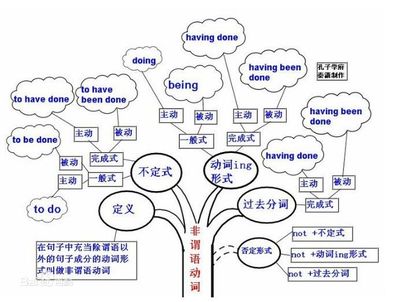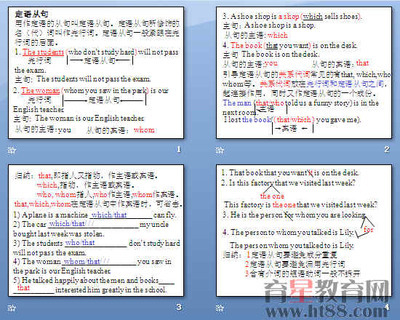分词分为现在分词和过去分词,具有动词、形容词和副词的特征,在句中作定语、补足语、表语或状语。其否定形式是直接在前面加not。分词的基本情况如下表所示:
类别
主动语态
被动语态
时间意义
语态意义
现在
分词
一般式
Doing
Being done
与谓语动词同时
或几乎同时发生
根据语态形式,
主动或被动意义
完成式
Having done
Having been done
发生在谓语动词之前
根据语态形式,
主动或被动意义
过去分词
done
无
表示动作完成
被动意义
v-ing形式作定语
1. 单个的v-ing形式可以作前置定语,表示所修饰的人或物的动作或状态,在意思上接近一个定语从句,可以表示正在进行的动作,也可表示经常性动作或当时的状态。
developing countries = countries that are developing 发展中国家
an ordinary-looking house = a house that looks ordinary 看起来很普通的房子
a puzzling problem = a problem that puzzles somebody 困扰人的问题
2. 作定语的v-ing形式如是一个短语,则应放在被修饰词的后面。
The bottle containing vinegar should be sent to the laboratory.
装着醋的那个瓶子应送到实验室去
They lived in a house facing south. 他们住在一所朝南的房子里。
3. 某些情况下,定语不能用v-ing形式,必须用定语从句。
① 作定语的动词-ing形式表示的动作要与主句谓语的动作同时发生,如两者不能同时发生的话,则需使用定语从句。
昨天来的教授将要给我们作一个讲座。
【误】The professor coming here yesterday will give us a lecture.
【正】The professor who came here yesterday will give us a lecture.
② v-ing形式的完成式一般只用作状语,不作定语。
被地震毁坏的庙宇很快就要重建了。
【误】The temple having been destroyed by the earthquake will be rebuilt soon.
【正】The temple which has been destroyed by the earthquake will be rebuilt soon.
v-ed形式作定语
1. 单个动词-ed形式作定语一般放在被修饰的名词之前,作前置定语。
A watched pot never boils. 心急锅不开。
All the broken doors and windows have been repaired.所有的坏门窗都修好了。
When we arrived, we each were given a printed question paper.
我们到达的时候,每人被发给了一份印制好的试卷。
提 示 如要表示强调,单个动词-ed形式也可作后置定语。
Money spent is more than money earned. 入不敷出。
2. 带有修饰语或其他成分的v-ed形式一般都作后置定语,在语法上相当于一个定语从句。
We have read many novels written by this author.
(= that are written by this author) 我们读过这个作家写的许多小说。
Half of the honored guests invited to the reception were foreign ambassadors.
(= who had been invited to the reception)
被邀请到招待会上的贵宾有一半都是外国大使。
The meeting, attended by one thousand students, was a success.
(= which was attended by one thousand students)
这次会议获得很大的成功,共有一千名学生出席了。
A woman dressed like a lawyer came in and took her seat as judge.
(= who was dressed like a lawyer)
一个律师装扮的女人走了进来,并作为法官就座。
v-ing 和v-ed形式作定语的区别
1.及物动词的-ing形式作定语表示与被修饰名词是主动关系,及物动词的-ed 形式表示与被修饰名词是被动关系。
The group called Green Hand is trying to help the environment.
The group calling itself Green Hand is trying to help the environment.
2.不及物动词-ing形式表示动词正在进行,而v-ed形式表示动作已完成。
the rising sun正在升起的太阳 the risen sun升起了的太阳
boiling water正沸腾的水 boiled water开水
falling leaves正在飘落的叶子 fallen leaves落叶
changing condition变化着的情况 changed condition改变了的情况
developing countries发展中国家 developed countries发达国家
不及物动词-ed形式只表示完成的意义,并不带有被动的含义。
an escaped prisoner = a prisoner who has escaped 逃犯
a retired worker = a worker who has retired 退休工人
a newly arrived guest = a guest who has just arrived 新来的客人
【考例1】 There have been several new events __ _ to the program for the 2008 Beijing Olympic Games.(06年北京卷) A. add B. to add C. adding D. added
解析 D。本题考查非谓语动词作定语用法,题干部分可改写为:There have been several new events (that have been) added to the program for the 2008 Beijing Olympic Games.
【考例2】 Five people won the “China’s Green Figure” award, a title ___ to ordinary people for their contribution to environmental protection.(06年山东卷)
A. being given B. is given C. given D. was given
解析 C。题中a title是award的同位语,后接非谓语动词短语作定语,因此可排除B,D两项。选项动词give与名词title之间是被动关系,且根据句意,give并非表示正在进行,因此用过去分词作定语。答案为C。
l As adverbs
v-ing形式作状语
动词-ing形式可以作状语,修饰动词,其动作执行者与句子主语是主动一致。在句中表示时间、原因、结果、条件、让步、行为方式或伴随情况等。动词-ing形式作时间、原因、条件、让步状语时多位于句首;作结果、伴随情况状语时常位于句末。
1 表示时间,相当于一个时间状语从句。
Having made full preparations, we are ready for the examination.
(= After we have made full preparations...)
2 表示原因,相当于一个原因状语从句。
Being ill, he didn't go to school yesterday. (= Since he was ill...)
3 表示结果,相当于一个并列谓语。
His father died, leaving him a lot of money. (= and left him a lot of money.)
4 表示条件,相当于一个条件状语从句。
Working hard at your lessons, you will succeed.
=If you work hard at your lessons...
5 表示让步,相当于一个让步状语从句。
Knowing all this, they made me pay for the damage.
= Although they knew all this...
6 表示行为方式、伴随情况或补充说明,相当于一个并列结构。
He lay on the grass, staring at the sky for a long time.
= ...and stared at the sky for a long time
v-ed形式作状语
动词-ed形式作状语和动词-ing形式作状语一样,也可以表示时间、原因、条件、让步、方式或伴随情况等。但其动作执行者与句子主语是被动一致。
1 动词-ed形式作状语表示时间,相当于一个时间状语从句。
Seen from the tower, the city looks beautiful.
(= When the city is seen from the tower...)
Completely examined by the doctors, he went back to school right away.
(= After he was completely examined...)
有时动词-ed形式前可加连词when, while等来强调时间概念。
Once recovered, he went all out to do his work.
一恢复健康,他就全力以赴地干起了工作。
When asked why she was late for class again, she hung her head in shame.
当被问到为什么上课又迟到时,她羞愧地低下了头。
Once started, the clock will go half a month and keep good time.
一旦给这钟上了发条,它就会走半个月,并且走得很准。
2 动词-ed形式作状语表示原因,相当于一个原因状语从句。
Moved by the heroic deeds, the children couldn't help crying.
(= Since they were moved by the heroic deeds ...)
Written in haste, her letter is very hard to read. (= As it was written in haste ...)
Excited by the new discovery, we decided to go out and celebrate.

(= Because we were excited by...)
3 动词-ed形式作状语表示条件,相当于一个条件状语从句。
Heated, water changes into steam. (= If water is heated...)
Given more time, he would be able to do better. (= If he was given more time ...)
Compared with other professors, she was an excellent speaker.
(= If she was compared with other professors...)
4 动词-ed形式作状语表示让步,相当于一个though/although引导的让步状语从句。
Exhausted by the running, they went on running after the robber.
(= Although they were exhausted by the running ...)
Laughed at by many people, he continued his research.
(= Even if he was laughed by ...)
为了使-ed形式表示的条件、动词让步意义更加明显,我们可以加上适当的连词。
Even if invited, I won't go. 即使受到邀请,我也不去。
Though beaten by the opposite team, they did not lose heart.
Unless invited, he will not come back to the company.
5 动词-ed形式作状语表示行为方式、伴随情况或补充说明时,通常位于句子的后面,相当于一个并列分句。
The teacher stood there, surrounded by the students.
(= and he was surrounded …)
He went into the office, followed by some children.
(= and he was followed by some children)
Tell the functions:
n Completely examined by the doctors, he went back to school right away.
n Having lived in this city for three years, she knows it very well.
n Laughed at by many people, he continued his study.
n He went into the office, followed by many children.
【考例3】When ___ _ different cultures, we often pay attention only to the differences without noticing the many similarities. (06年浙江卷)
A. compared B. being compared C. comparing D. having compared
解析 C。选项动词compare与句子主语之间是主动关系,根据语意选项动词并非发生在谓语动词之前,所以用现在分词的一般式的主动语态作状语,表示时间。正确答案为C。
【考例4】 ___ for the breakdown of the school computer network, Alice was in low spirits.(06年福建卷) A. Blaming B. Blamed C. To blame D. To be blamed
解析 B。blame sb. for sth.意为因某事责怪某人,题中blame与主语之间是被动关系,所以用过去分词作状语,表示原因。 注意:在英语中有些表示说话人态度的分词结构已成为固定用语,不遵循其逻辑主语与句子一致的原则。如:generally speaking总的来说;judging from根据……判断; speaking of说到……;talking of谈到……;considering考虑到。
 爱华网
爱华网

